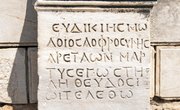While it is considered long dead since it is not a spoken or written language that is significantly used by any large cultural body, Latin continues to have an impact on the world of language. Finding out how your name is pronounced or spelled in Latin is an interesting endeavor that uncovers more than the letters that make up your name. To translate English to Latin, there are a few simple and basic rules to consider.
Brief History of Latin
To understand how and why Latin is significant in today’s language even though it isn’t frequently used in modern culture, you need to go back to at least the Middle Ages. Scholar monks and bishops conversed and wrote in Latin, which later meant schools and university students also needed to understand Latin to relate to the learned teachers. When the students enrolled in classes with their English, French, Italian or German names, they were hard to pronounce by their Latin professors. They changed their names to a Latin conversion in order to better converse and debate with classmates and scholars without awkwardly stumbling around each other’s harsher-sounding modern Middle Age names.
Why Did the Latin Language Die?
The Roman empire fell in the West in A.D. 476. That was also the beginning of the end for the reign of Latin as a language. It then evolved into dialects in regions where the Romans had once been prominent. It slowly changed in subtle ways in areas that continued to see serious growth, wars, coups, takeovers and other historical events. This is from where the romance languages broke off and became significantly different over hundreds and hundreds of years. The Latin of the Romans turned to Italian, French, Spanish and even German and English. Latin was taught in schools up through the last century as a mandatory part of many curriculums of higher learning around the world.
How to Convert Male Names
While name translators abound online, a few basic rules can assist you in easily translating an English name to Latin. If you prefer to convert to a male name regardless of your gender, add the Latin suffix of “us” to your first name. For instance, if your name is Joan or Robert it would become Joanus or Robertus. For names that end in the suffix “us,” such as Jesus, you will still add an “us.” This makes a name that ends in “us” a double "us," as in “Jesusus.” For male names that end in the letter “y,” such as Barry, it would become Barryus.
Names that are found in the Bible are basically the same. However, John is spelled differently. John becomes Ioannes, which is originally derived from the Greek name of the same spelling and meant “God is gracious” in an English translation of ancient Hebrew.
It’s not always easy to find an exact translation of English names in Latin, but this should bring you fairly close to an authentic and modern Latin translation of your name. Considering that Latin itself is an evolved language from more than 2,000 years ago, any attempt to translate contemporary names to Latin is authentic in its own way.
How to Convert Female Names
To change a female name to Latin, it takes just one letter. Add an “a” to the end of a female name. Jane would become Janea. This would be pronounced “Jay-nee-a.” For names such as Carly, Maddy or Mary, the letter “y” is turned into an “i,” and the “a” is added after that. So, Mary would be “Maria.” There are many ways to turn a modern name into a Latin equivalent, but these are the basic rules that should help you to arrive at a relatively authentic Latin translation of your name.
Related Articles
References
Writer Bio
Kimberley McGee is an award-winning journalist with 20+ years of experience writing about education, jobs, business trends and more for The New York Times, Las Vegas Review-Journal, Today’s Parent and other publications. She graduated with a B.A. in Journalism from UNLV. Her full bio and clips can be seen at www.vegaswriter.com.










